WORLD CLASS COACHING
Tactical Series
Jurgen Klopp
By Alexander Trukan
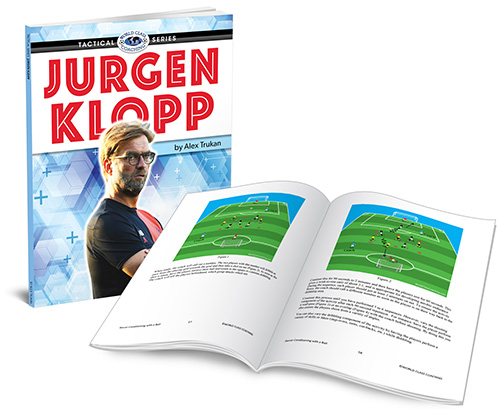
DEFENDING
If the initial press was not effective and the possession wasn’t regained until the ball is played away into different space, the team needs to reorganise and shape a defending structure to win the ball back from. Klopp’s teams prefer a direct approach using high pressing and compactness to win the ball back as soon as possible even when organised. Central areas get overloaded and the opposition is forced into the middle into a pressing trap to regain possession. This phase requires a lot more defensive structure and detail than initial transition to defence.
Preventing building up from the back
When the opposition team decides to build up from the back through the back line, Klopp’s teams will allow this as it increases the chances of winning the ball closer to the opposition goal and suits high pressing teams well. As soon as the centre backs receive the ball, forwards unit would be looking to apply pressure and force play in certain direction. In most of the cases, this would be into central areas. The reason for this is narrowness of Klopp’s teams both in attack and defence what means that central areas will be overloaded and easier to win the ball back in. This is achieved by first defender curving his run from outside in to cut off an option to full back and force central defender inside by pressurising him. Second striker would be looking to get closer to the other centre back, preventing the ball being played into him. This will force player in possession to either play into midfield or back into the goalkeeper.
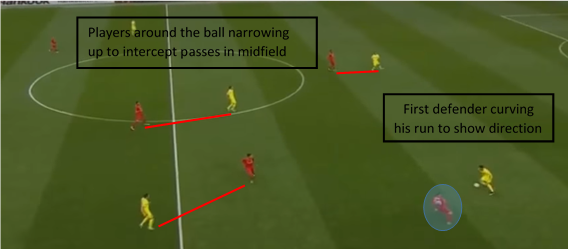
When playing with a front three, as the winger pressurises from the outside, central striker cuts the option to the other centre back and the opposite winger drops deeper into midfield to overload central areas. Three midfielders would be looking to block passing options, man mark players within their zones and try to intercept any passes coming through.
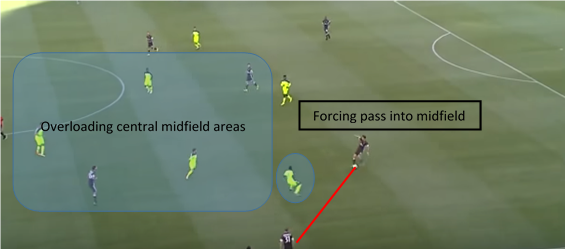
Similar picture happens when the opposition insists on playing through the thirds and their centre backs drop into the sides of the penalty box to receive. This provides even better opportunity to win the ball back as it’s easier to isolate player on the ball and force into desired areas. In this situation, other striker will be looking to come across narrower and cut the option to switch between centre backs as well as affect their midfielder dropping deeper to receive.
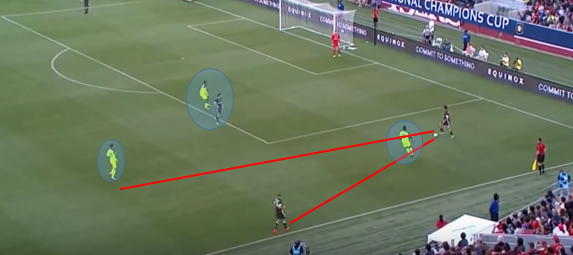
As soon as the pass is made into central areas, the player receiving the ball should be immediately closed down and forced to lose the ball or pass backwards. The starting position of the pressurising midfielder should allow him to intercept the pass as well as prevent the receiver from turning away. Two strikers in front of the ball would be looking to penetrate forwards in case possession is won.
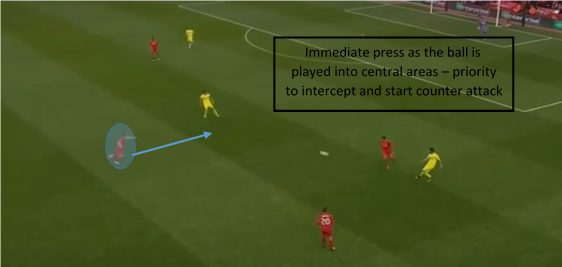
As it can be seen below, due to narrow shape, central areas are overloaded and easier to win the ball back in. As the ball is moving and pressure applied, it is crucial role for players around the ball to adjust their positions and cut off nearest passing options, at the same time, reducing the space for the player on the ball.
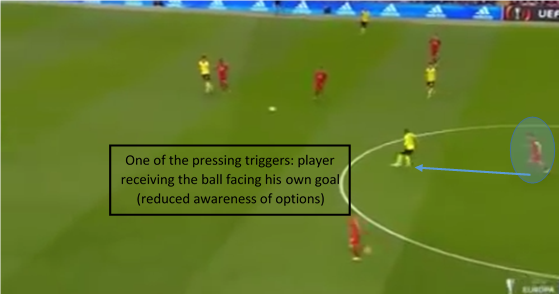
In case forcing centrally is not available, or the opposition managed to switch play and create an opportunity to play wide, Klopp’s team would try to set a pressing trap in those areas. As the centre back turns his body to play into full back, pressurising striker will pressurise from inside and cut the option to play sideways. Central midfielders would come across as the ball moves and mark within their zone. Wide midfielder/winger would in turn delay his press on the full back and remain more centrally to allow the space for the pass to be played.
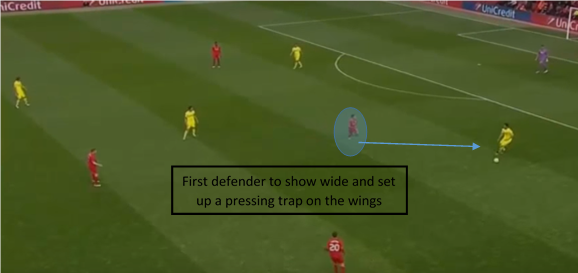
As soon as the full back receives the ball, a leeway pressing is applied as described in a previous chapter. First defender (wide midfielder) curves his run to force back or sideways. Players around the ball narrow up and get closer to the ball remaining on the passing lines. The key is to cut off all the nearest options and overload areas closest to the ball.
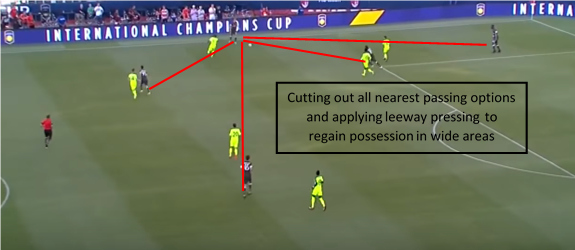
What distinguishes Klopp’s Liverpool from many other teams is one of the variations of pressing in wide areas – allowing the pass into half space and then pressurising player on the ball. These half spaces near to wide areas will be usually occupied by defensive/central midfielders dropping to receive, and often having limited vision to play forwards due to body position (in the example below, midfielder managed to turn and face forwards as the press was delayed). This creates advantegous opportunity to apply pressure and double up to get in possession. Winning the ball back in those half spaces provides more opportunities to counter attack comparing to when the ball is won in wide areas. This is due to more options open (left, right and centrally).
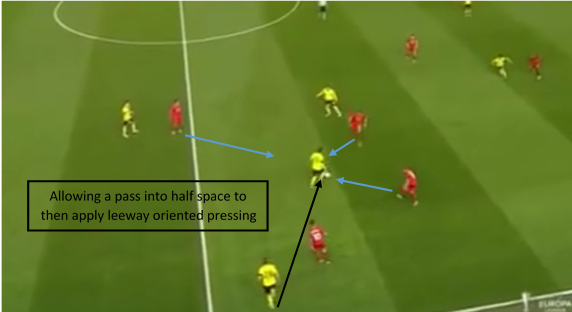
Another defending aspect specific to Klopp’s teams is applying pressure from behind. In case opposition player manages to get past the strikers unit, he would still be under pressure from forward chasing from behind. If combined with a pressure from the front, it can create a great opportunity to win the ball back as a safe option to play backwards would be denied. Player driving forwards has limited vision what’s happening in behind and is focusing on players pressing from the front. This further increases the chances of winning possession.
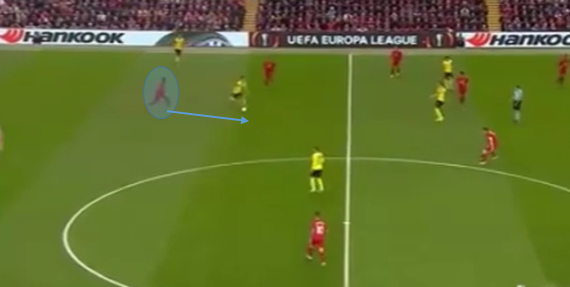
There will be times, however, when the ball is played backwards, potentially into the goalkeeper. Klopp’s teams in most of the cases would be still looking to press the goalkeeper and force a long pass. This prevents the opposition from playing back to the centre backs and reorganising attacking shape. As the ball is played back to the goalkeeper, the opposition will be still positioned away from each other, using the space on the pitch effectively. This means that the distances between players will be bigger and it will be harder to be effective in receiving a long ball/winning second balls. Applying pressure on the goalkeeper also creates a psychological pressure on the opposition.
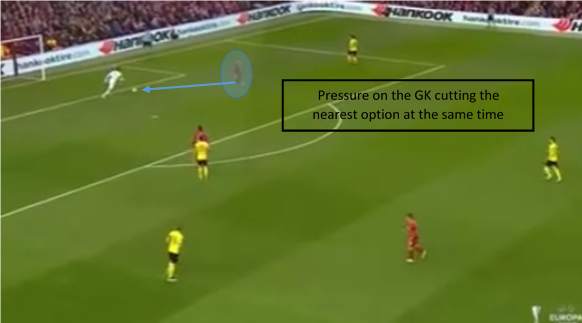
Preventing creating chances and scoring
When the opposition beats the pressing block and the ball gets to the defending half, a team would be looking to reorganise and defend deeper with emphasis on protecting central areas and trying to counter attack as soon as possible. In the analysed Liverpool games, the team preferred mainly two shapes when defending on their own half: 4-2-3-1 and 4-1-4-1. In both of the variations, one striker was left in front of the ball to initiate the counter attack. Depending on the opposition, this might have been more holding (Origi) or penetrating forward (Sturridge, Mane). Midfield unit would be looking to narrow up the distances between each other and move in relation to the ball to prevent any passes through midfield. Zonal orientation would apply with man to man marking within each player’s zone. When playing with two holding midfielders, it is more difficult for the opposition to play a through ball into the striker. This option is usually preferred with more direct opposition. The weakness is more space for the opposition to get the ball wide and attack through the wings.
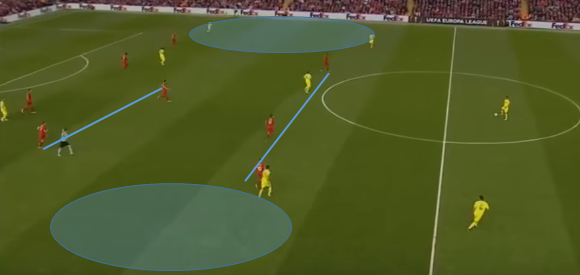
When playing with one holding midfielder and four players in midfield line, it is easier to prevent passes into wide midfielders and full backs, at the same time, forcing the opposition to play centrally. Regardless of the shape, striker’s pressing from behind applies on the own half as well. Lone striker up front might seem detached from defending but it’s only a false impression. His role is to get between the ball and centre backs to prevent back passes as well as to press from behind if the opportunity arises.
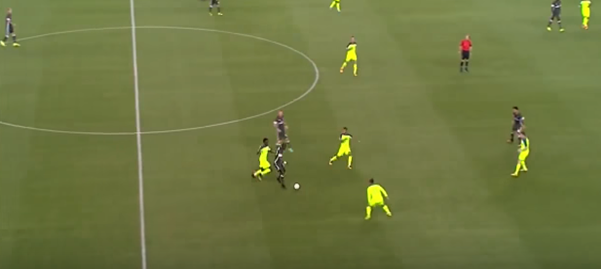
Similarly to pressing from the front, defending on the own half is initiated off certain triggers. One of the main trigger used by Klopp’s teams is opposition player facing his own goal. This is a trigger for the nearest player to pressurise and try to win the ball back or force backwards. Other triggers might include: poor quality of pass, receiving mistake, limited support available or pass played into certain zone.
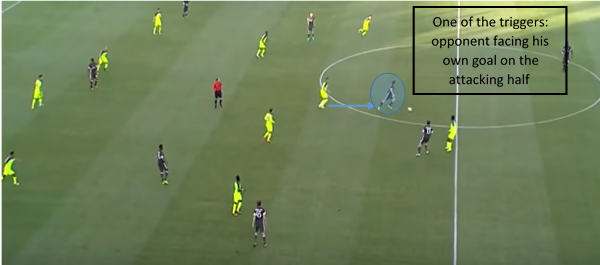
Defending deeper requires similar level of intensity and aggresiveness when pressing as defending from the front. As the ball is played into opposition midfielder positioned deeper on the defending half (starting point for pressing should be agreed), he should be immediately closed down. Klopp’s teams prefer to double up in central areas as well. This should prevent the midfielder from turning and playing forwards. Players around the ball need to get narrower and support from the back.
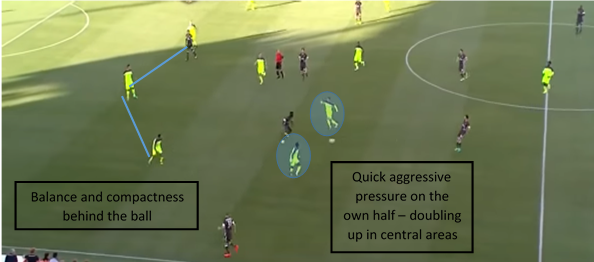
Compactness in central areas will force the opposition to play wide most of the time. When the ball is wide, playing with at least one holding midfielder provides an opportunity for him to drop between centre backs and switch to false back five when the ball is wide. This will allow to have more players on the ball side of the pitch and at the same time be wide enough to react and slide across in case the ball is switched.
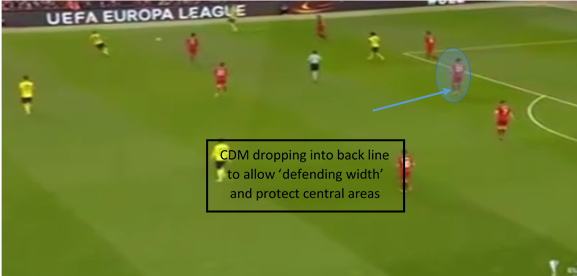
One of the main characteristics of Klopp’s teams discussed before – ball orientation and high intensity pressing, provides serious threat in case the opposition plays through or around. For example, if the defending team decides to double on the own half, there will be spaces left away from the ball which might be not sufficiently covered. This is why, players around the ball narrowing up spaces are crucial. As it can be seen below, two central midfielders decided to double up and press, however, left midfielder is late to get compact what leaves big gap of space for opposition midfielder to drive in.
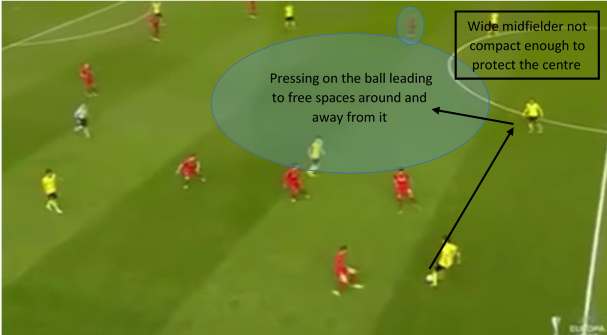
Technical details when defending on the own half play a big role. Body position of the supporting defender might allow or prevent him from intercepting a pass. Similarly, angle of approach will force where the ball will go next. Details matter when defending and often determine whether possession is won back or opposition manages to play through.
Training practices
Leading in – Wave Practice 2v2
Set up and organization
Organise a pitch of 30 x 35 yards. Mark out two wide channels, 5 yards in from the touchline. Divide the group into two teams and then further into pairs within team. One team has a starting position behind one goal, the other one, behind the opposite goal. Organise goalkeepers in goals. Prepare a sufficient amount of balls to ensure flow and intensity of the practice.
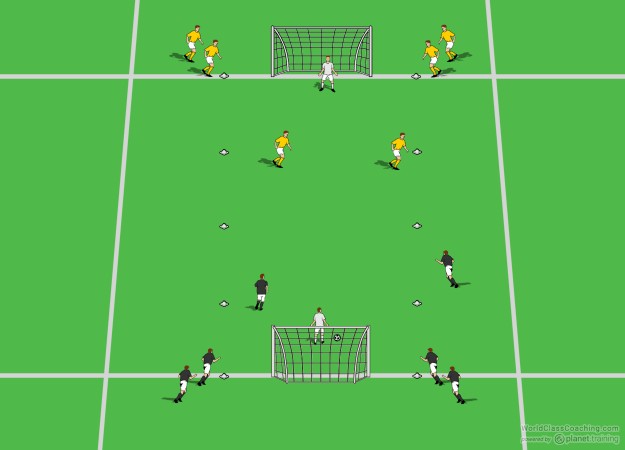
The practice starts with a goalkeeper passing the ball out into one of the attacking pairs stepping forwards. Another pair from the opposite side starts defending. The aim is to score into the opposite goal. If the attacking pair scores from the middle channel, they get 3 points. Scoring from wide channel is worth 1 point.
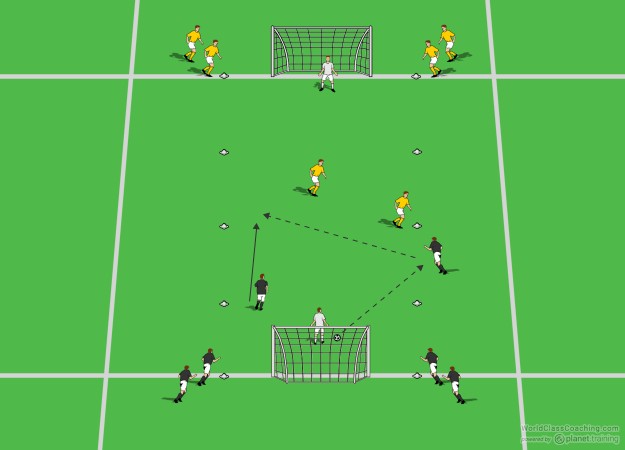
This condition for the attacking team will encourage defenders to force the attackers into wide areas rather than into the middle. The same rule might be flipped the opposite way, what will help the defending team to force centrally rather wide (position of the goal might be also adjusted).
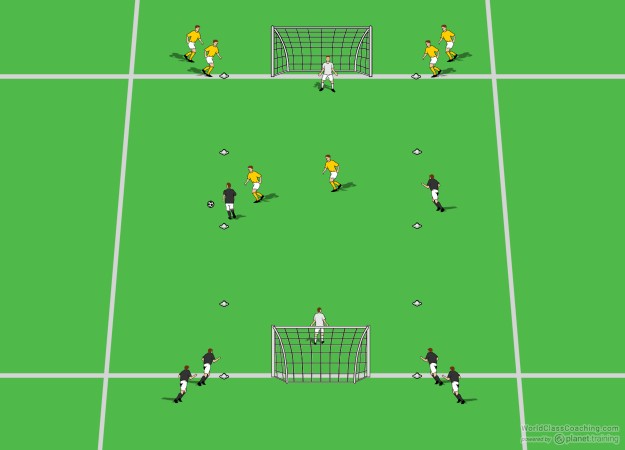
Main part – Phase of Play 9v9
Set up and organization
Prepare 2/3 of the full size pitch. Mark out wide channels between the side of the penalty box and the touchline. Organise two full size goals places opposite each other. Cut off the angles of the pitch on the side nearer to the half way line as shown on the diagram below. Divide the group into two teams of 9 (8+GK). Attacking team (blacks) plays with four defenders, three midfielders and one striker up front. Defending team (yellows), plays with two central defenders, four midfielders and two strikers (2-4-2). Goalkeepers should be set and ready in goals. Prepare a sufficient amount of balls to ensure intensity and flow.
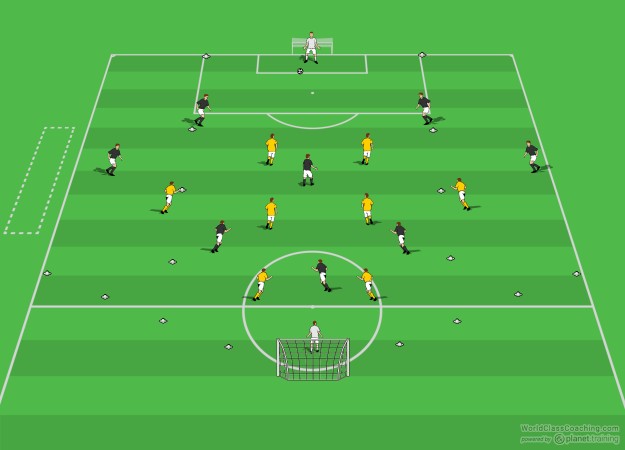
The practice starts with a goalkeeper of the black team playing out from the back into one of the back line players. Both teams attempt to score into opposite goals. If the defending team wins the ball in the central area and scores, it would be worth 3 points. If the ball is won in the wide areas and a goal is scored, it counts as 1 point. Again, this might be flipped opposite way to encourage the defending team to force wide rather than centrally. There are no corners, the play restarts from a goalkeeper of the attacking team.
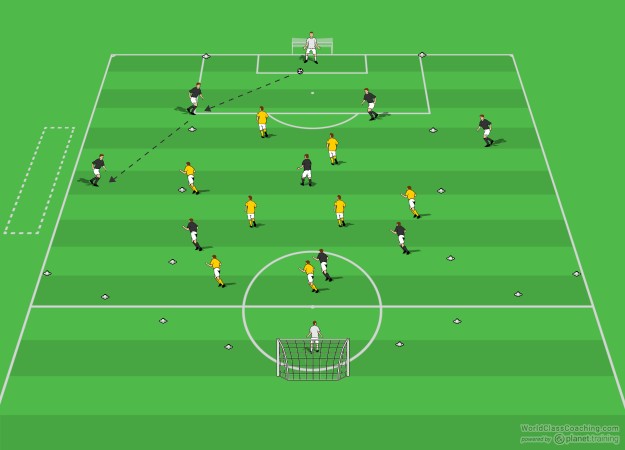
This practice provides a lot of opportunities to defend from the front and make transitions to attack. It paints similar pictures to those happening during the game, making it easier for players to understand the concepts. It also allows the coach to work position specifically and in formations related to the nearest game and a model of play.
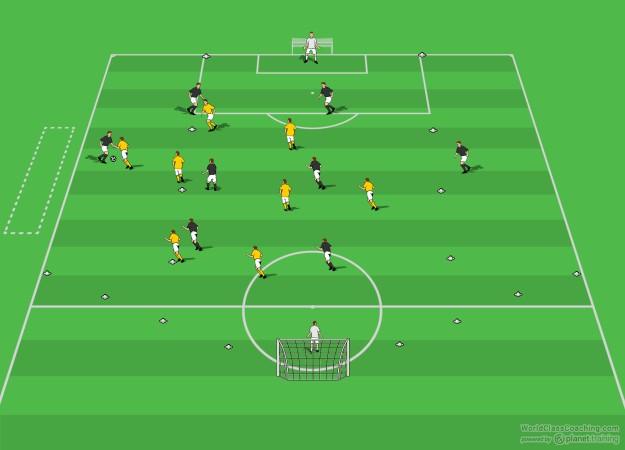
This practice can be progressed with adding additional player into attacking team and making it a 10v9 phase of play. This will challenge the defenders to overload areas around the ball more effectively and get compact and narrow.


